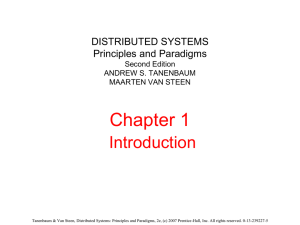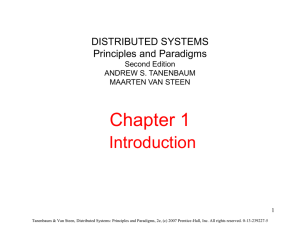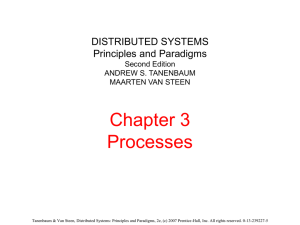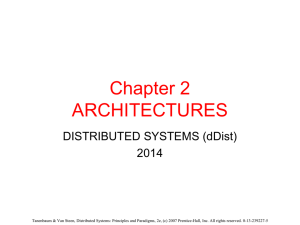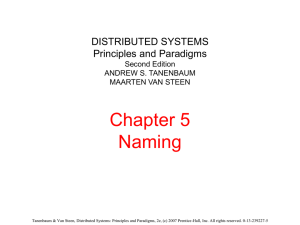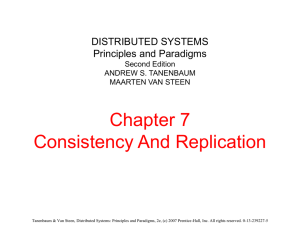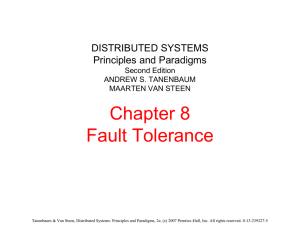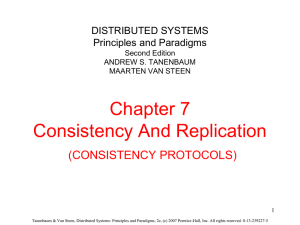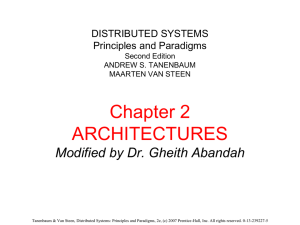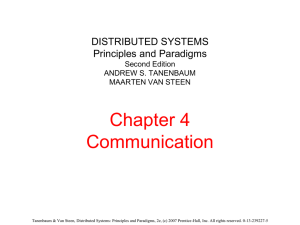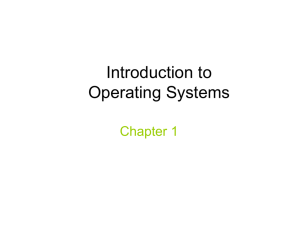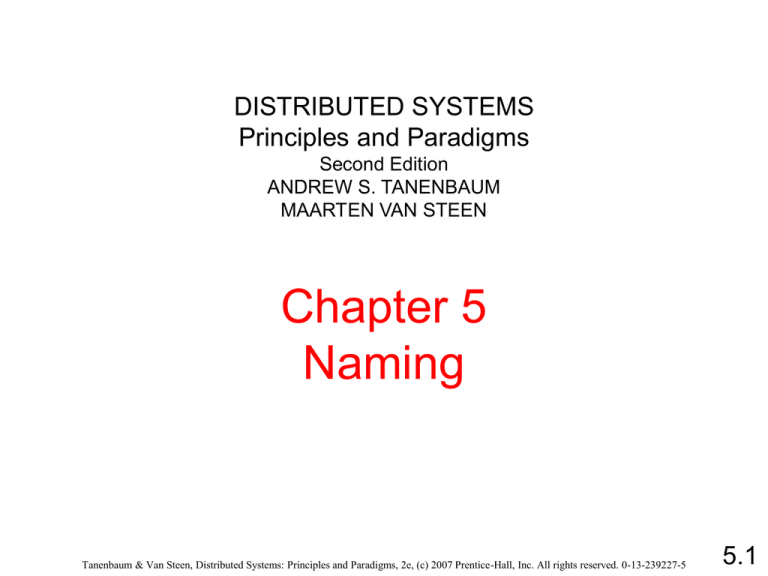
DISTRIBUTED SYSTEMS
Principles and Paradigms
Second Edition
ANDREW S. TANENBAUM
MAARTEN VAN STEEN
Chapter 5
Naming
Tanenbaum & Van Steen, Distributed Systems: Principles and Paradigms, 2e, (c) 2007 Prentice-Hall, Inc. All rights reserved. 0-13-239227-5
5.1
Naming
•
•
•
•
Names denote entities in a
distributed system.
To operate on an entity, we access it
at an access point.
Access points are entities named by
an address.
A location-independent name for
an entity E, is independent from the
addresses of the access points
offered by E.
Tanenbaum & Van Steen, Distributed Systems: Principles and Paradigms, 2e, (c) 2007 Prentice-Hall, Inc. All rights reserved. 0-13-239227-5
5.2
True Identifiers
•
•
Pure name: One with no meaning; just a
random string used for comparison.
Identifier: A name with these properties:
–
–
–
•
Each identifier refers to at most one entity
Each entity referred to by at most one identifier
An identifier always refers to the same entity (prohibits
reusing an identifier)
An identifier need not necessarily be a pure
name, i. e., it may have content.
Tanenbaum & Van Steen, Distributed Systems: Principles and Paradigms, 2e, (c) 2007 Prentice-Hall, Inc. All rights reserved. 0-13-239227-5
5.3
Naming vs. Locating Entities (1)
•
Location service: Provides current
addresses of entities.
– Entities are mobile - current address
may change often.
•
Naming service: Provide content of
nodes in a name space given a
name.
– Node contents at higher levels is
relatively stable.
Tanenbaum & Van Steen, Distributed Systems: Principles and Paradigms, 2e, (c) 2007 Prentice-Hall, Inc. All rights reserved. 0-13-239227-5
5.4
Naming vs. Locating Entities (2)
•
If traditional naming service used to locate
entities, must assume node contents at local
level is stable.
•
Not realistic to assume stable node contents
down to the local naming level
•
Decouple naming and locating entities.
Tanenbaum & Van Steen, Distributed Systems: Principles and Paradigms, 2e, (c) 2007 Prentice-Hall, Inc. All rights reserved. 0-13-239227-5
5.5
Broadcasting & Multicasting
•
Broadcasting works only in LANs
– Too much load on Network
– Too much load on machines that
can’t answer
•
Multicasting
– Possible in LAN hardware
– not well supported at IP layer
– Can use to find a nearest replica
Tanenbaum & Van Steen, Distributed Systems: Principles and Paradigms, 2e, (c) 2007 Prentice-Hall, Inc. All rights reserved. 0-13-239227-5
5.6
Forwarding Pointers (1)
When an entity moves, it leaves a pointer to where
it went.
•
Dereferencing can be made transparent to
client - follow the pointer chain
• Update client's reference when location is
found
• Geographical scalability problems:
– Long chains not fault tolerant
– High latency when dereferencing
Need chain reduction mechanisms
Tanenbaum & Van Steen, Distributed Systems: Principles and Paradigms, 2e, (c) 2007 Prentice-Hall, Inc. All rights reserved. 0-13-239227-5
5.7
Forwarding Pointers (1)
Figure 5-1. The principle of forwarding pointers
using (client stub, server stub) pairs.
Tanenbaum & Van Steen, Distributed Systems: Principles and Paradigms, 2e, (c) 2007 Prentice-Hall, Inc. All rights reserved. 0-13-239227-5
5.8
Forwarding Pointers (2)
Figure 5-2. Redirecting a forwarding pointer by
storing a shortcut in a client stub.
Tanenbaum & Van Steen, Distributed Systems: Principles and Paradigms, 2e, (c) 2007 Prentice-Hall, Inc. All rights reserved. 0-13-239227-5
5.9
Forwarding Pointers (3)
Figure 5-2. Redirecting a forwarding pointer by
storing a shortcut in a client stub.
Tanenbaum & Van Steen, Distributed Systems: Principles and Paradigms, 2e, (c) 2007 Prentice-Hall, Inc. All rights reserved. 0-13-239227-5
5.10
Home-Based Approaches
Figure 5-3. The principle of Mobile IP.
Tanenbaum & Van Steen, Distributed Systems: Principles and Paradigms, 2e, (c) 2007 Prentice-Hall, Inc. All rights reserved. 0-13-239227-5
5.11
Home-Based Approaches (2)
Problems with home-based approaches:
•
•
•
Home address has to be supported as
long as entity lives
Home address is fixed - unnecessary
burden if entity permanently moves
Poor geographical scalability (the entity
may be next to the client)
Tanenbaum & Van Steen, Distributed Systems: Principles and Paradigms, 2e, (c) 2007 Prentice-Hall, Inc. All rights reserved. 0-13-239227-5
5.12
Hierarchical Approaches
Figure 5-5. Hierarchical organization of a location service into
domains, each having an associated directory node.
5.13
Tanenbaum & Van Steen, Distributed Systems: Principles and Paradigms, 2e, (c) 2007 Prentice-Hall, Inc. All rights reserved. 0-13-239227-5
Name Spaces (1)
Figure 5-9. A general naming graph with a single root node.
Tanenbaum & Van Steen, Distributed Systems: Principles and Paradigms, 2e, (c) 2007 Prentice-Hall, Inc. All rights reserved. 0-13-239227-5
5.14
Name Spaces (2)
Figure 5-11. The concept of a symbolic link
explained in a naming graph.
Tanenbaum & Van Steen, Distributed Systems: Principles and Paradigms, 2e, (c) 2007 Prentice-Hall, Inc. All rights reserved. 0-13-239227-5
5.15
Linking and Mounting (1)
Merging Name Spaces
Problem: To reach different name spaces from any
given name space.
Solution 1: A naming scheme by which pathnames of
different name spaces are concatenated (URLs).
ftp://ftp.cs.vu.nl/pub/steen
ftp
Name of protocol used to talk with server
://
Name space delimiter
ftp.cs.vu.nl
Name of a node representing an FTP server, and containing the IP address
of that server
/
Name space delimiter
pub/steen
Name of a (context) node in the name space rooted at the context node
mapped to the FTP server
Tanenbaum & Van Steen, Distributed Systems: Principles and Paradigms, 2e, (c) 2007 Prentice-Hall, Inc. All rights reserved. 0-13-239227-5
5.16
Linking and Mounting (2)
Figure 5-12. Mounting remote name spaces
through a specific access protocol.
Tanenbaum & Van Steen, Distributed Systems: Principles and Paradigms, 2e, (c) 2007 Prentice-Hall, Inc. All rights reserved. 0-13-239227-5
5.17
Linking and Mounting (3)
Merging Name Spaces
Mount point: (Directory) node in
naming graph that refers to other
naming graph
Mounting point: (Directory) node in
other naming graph that is referred
to.
Tanenbaum & Van Steen, Distributed Systems: Principles and Paradigms, 2e, (c) 2007 Prentice-Hall, Inc. All rights reserved. 0-13-239227-5
5.18
Name Space Distribution (1)
Figure 5-13. An example partitioning of the DNS name space,
including Internet-accessible files, into three layers.
5.19
Tanenbaum & Van Steen, Distributed Systems: Principles and Paradigms, 2e, (c) 2007 Prentice-Hall, Inc. All rights reserved. 0-13-239227-5
Name Space Distribution (2)
•
•
Basic issue: Distribute name process & name
space management across multiple machines
by distributing nodes of the naming graph.
A hierarchical naming graph with three levels:
–
–
–
Global level: Consists of the high-level directory
nodes. These directory nodes have to be jointly
managed by different administrations.
Administrative level: Contains mid-level directory
nodes that can be grouped in such a way that each
group can be assigned to a separate administration.
Managerial level: Consists of low-level directory
nodes within a single administration. Main issue is
effectively mapping directory nodes to local name
servers.
Tanenbaum & Van Steen, Distributed Systems: Principles and Paradigms, 2e, (c) 2007 Prentice-Hall, Inc. All rights reserved. 0-13-239227-5
5.20
Name Space Distribution (2)
Figure 5-14. A comparison between name servers for
implementing nodes from a large-scale name space
partitioned into a global layer, an administrational
layer, and a managerial layer.
Tanenbaum & Van Steen, Distributed Systems: Principles and Paradigms, 2e, (c) 2007 Prentice-Hall, Inc. All rights reserved. 0-13-239227-5
5.21
Implementation of Name Resolution (1)
Figure 5-15. The principle of iterative name resolution.
Tanenbaum & Van Steen, Distributed Systems: Principles and Paradigms, 2e, (c) 2007 Prentice-Hall, Inc. All rights reserved. 0-13-239227-5
5.22
Implementation of Name Resolution (2)
Figure 5-16. The principle of recursive name resolution.
Tanenbaum & Van Steen, Distributed Systems: Principles and Paradigms, 2e, (c) 2007 Prentice-Hall, Inc. All rights reserved. 0-13-239227-5
5.23
Example: The Domain Name System
Figure 5-18. The comparison between recursive and iterative
name resolution with respect to communication costs.
Tanenbaum & Van Steen, Distributed Systems: Principles and Paradigms, 2e, (c) 2007 Prentice-Hall, Inc. All rights reserved. 0-13-239227-5
5.24
Scalability Issues (1)
•
Size scalability: Need to ensure servers can
handle large number of requests per time unit
–
•
•
high-level servers are in big trouble.
Solution: Assume that node content at global and
administrative level rarely changes. Apply
extensive replication by mapping nodes to multiple
servers, and start name resolution at the nearest
server.
Observation: An important attribute of many
nodes is the address where the represented
entity can be contacted. Replicating nodes makes
large-scale traditional name servers unsuitable for
locating mobile entities.
Tanenbaum & Van Steen, Distributed Systems: Principles and Paradigms, 2e, (c) 2007 Prentice-Hall, Inc. All rights reserved. 0-13-239227-5
5.25
Scalability Issues (2)
•
Geographical scalability: Need to
ensure that name resolution process
scales across large distances.
•
Problem: By mapping nodes to servers
that may be located anywhere, we
introduce implicit location dependency.
•
Solution: No general one available yet.
Tanenbaum & Van Steen, Distributed Systems: Principles and Paradigms, 2e, (c) 2007 Prentice-Hall, Inc. All rights reserved. 0-13-239227-5
5.26
The DNS Name Space
Figure 5-19. The most important types of resource records
forming the contents of nodes in the DNS name space.
5.27
Tanenbaum & Van Steen, Distributed Systems: Principles and Paradigms, 2e, (c) 2007 Prentice-Hall, Inc. All rights reserved. 0-13-239227-5
DNS Implementation (1)
Figure 5-20. An excerpt from the DNS
database for the zone cs.vu.nl.
Tanenbaum & Van Steen, Distributed Systems: Principles and Paradigms, 2e, (c) 2007 Prentice-Hall, Inc. All rights reserved. 0-13-239227-5
5.28
DNS Implementation (2)
Figure 5-20. An excerpt from the DNS
database for the zone cs.vu.nl.
Tanenbaum & Van Steen, Distributed Systems: Principles and Paradigms, 2e, (c) 2007 Prentice-Hall, Inc. All rights reserved. 0-13-239227-5
5.29
Hierarchical Implementations: LDAP (1)
Figure 5-22. A simple example of an LDAP
directory entry using LDAP naming conventions.
Tanenbaum & Van Steen, Distributed Systems: Principles and Paradigms, 2e, (c) 2007 Prentice-Hall, Inc. All rights reserved. 0-13-239227-5
5.30
Hierarchical Implementations: LDAP (2)
Figure 5-23. (a) Part of a directory information tree.
Tanenbaum & Van Steen, Distributed Systems: Principles and Paradigms, 2e, (c) 2007 Prentice-Hall, Inc. All rights reserved. 0-13-239227-5
5.31
Hierarchical Implementations: LDAP (3)
Figure 5-23. (b) Two directory entries
having Host_Name as RDN.
Tanenbaum & Van Steen, Distributed Systems: Principles and Paradigms, 2e, (c) 2007 Prentice-Hall, Inc. All rights reserved. 0-13-239227-5
5.32
Mapping to Distributed Hash Tables (1)
Figure 5-24. (a) A general description of a resource.
(b) Its representation as an AVTree.
Tanenbaum & Van Steen, Distributed Systems: Principles and Paradigms, 2e, (c) 2007 Prentice-Hall, Inc. All rights reserved. 0-13-239227-5
5.33
Mapping to Distributed Hash Tables (2)
Figure 5-25. (a) The resource description of a query.
(b) Its representation as an AVTree.
Tanenbaum & Van Steen, Distributed Systems: Principles and Paradigms, 2e, (c) 2007 Prentice-Hall, Inc. All rights reserved. 0-13-239227-5
5.34
UDDI
Universal Discovery Description
and Integration
• Can offer Web service without
registering in UDDI
• "Yellow Pages" of Web
services.
• Search for services needed
Tanenbaum & Van Steen, Distributed Systems: Principles and Paradigms, 2e, (c) 2007 Prentice-Hall, Inc. All rights reserved. 0-13-239227-5
5.35
UDDI
•
•
XML file that describes a business and
the services it offers
Three parts to an entry
– “White pages" describe the company
– “Yellow pages" include industrial categories
– “Green pages" describe interface to
service
Tanenbaum & Van Steen, Distributed Systems: Principles and Paradigms, 2e, (c) 2007 Prentice-Hall, Inc. All rights reserved. 0-13-239227-5
5.36
UDDI
•
Services defined by a Type Model
– AKA tModel
•
•
tModel may contain a WSDL file
that describes a SOAP interface to
a Web service
flexible enough to describe almost
any kind of service
Tanenbaum & Van Steen, Distributed Systems: Principles and Paradigms, 2e, (c) 2007 Prentice-Hall, Inc. All rights reserved. 0-13-239227-5
5.37
UDDI
•
UDDI directory includes several ways
to search
– providers of a service in a certain
location
– business of a specified type
•
•
Directory will supply information,
contacts, links, and technical data
Allows us to evaluate which services
meet our requirements
Tanenbaum & Van Steen, Distributed Systems: Principles and Paradigms, 2e, (c) 2007 Prentice-Hall, Inc. All rights reserved. 0-13-239227-5
5.38

